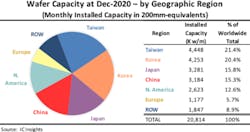The Global Semiconductor Shortage, Understanding and Preparing for the Future
The market for semiconductors has been volatile in the last 2 years and experts predict supply chain challenges across the semiconductor industry will extend to late 2023 and early 2024. To address changing market conditions, S&P Global Engineering Solutions spends in-depth, one-on-one time with our customers focused on the electronic component supply chain and the roots of this complex issue. In this article, we will share some of our perspectives on the current shortage and the steps industry practitioners are taking to mitigate such challenges.
Why is there a semiconductor shortage?
For professionals in the semiconductor industry, shortages (often referred to as allocation) are not new; they are cyclical in nature. Shortages can be caused by natural disasters, variations in the supply of semiconductor material, changing economic conditions, or other geographic and political events. Historically, these periods of electronic component allocation have typically been short lived (6 months to a year), but the current chip shortage is an unprecedented deviation to that trend.
Over the last decade, the market has seen many businesses moving toward just-in-time inventory strategies. This is cost-effective and efficient when the supply chain is without shortages, because a just-in-time system saves businesses on inventory storage space and costs as they reduce their supply chain inventory. Consequently, businesses depend on factory capabilities to accurately increase and decrease production based on their forecasted orders and inventory pipeline. Most semiconductor manufacturing facilities (called fabs) operate at around 80% utilization and modify this operating capacity to accommodate fluctuations in demand. The unpredictable events of the past 2 years have disrupted this operating rhythm, presenting businesses with the supply chain shortages they are facing today.
Covid-19 impact on the semiconductor industry
At the beginning of the pandemic in 2020, car manufacturers drastically reduced their semiconductor chip orders in anticipation of a major downturn in sales. Yet as they reduced production, the need for digital transformation accelerated as online schooling and large numbers of employees began working from home. Sales increased for home IT equipment enabling internet and video conferencing, and demand grew for smartphones and recreational products like PlayStations and VR headsets to adapt to time in lockdown.
As demand for consumer products increased, semiconductor production lines transitioned from producing the lower cost car chips to producing more expensive processors and other devices from current orders. By the time the auto industry saw an increase in customer demand and reinstated their chip orders, the foundries’ space had already filled with other products. Much of the microcontroller inventory had already been sold into phones, recreational devices and IT products. This set the stage for the automotive chip shortage. Semiconductor fabs increased capacity to over 95% utilization to maximize the number of chips produced but were still unable to meet the increased demand.
The global shutdown affected semiconductor manufacturing companies across the world, unilaterally stopping wafer production. Fabs in some countries were offline longer than others and, depending on how the production line was paused, it took weeks to months to bring a fab back online. Once a fab is online, it takes 26 weeks to fill the production pipeline from wafer start to completion. Wafers are processed in lots or batches that take 12 weeks to cycle through the fab (14 to 20 weeks for complex process technologies). An additional 12 to 14 weeks are required for testing, die bonding and packaging. Manufacturers prioritized the existing semiconductor inventory to fill orders, so as fabs came back online, production was already lagging demand. Longer lead times made it difficult to meet demands, and semiconductor manufacturers found that increasing capacity was not enough to make up for the difference between supply and demand.
Other factors causing the semiconductor chip shortage
In addition to the Covid-19 pandemic and its effects on the global supply chain, there were other unforeseen events that halted semiconductor production and worsened global supply chain issues:
- The Renesas fab in Japan caught fire in March 2021, taking microcontroller production offline for 3 months. Most of these devices supported the automotive industry.
- In February 2022, there was an ice storm in Texas and the accompanying power outage took NXP, Samsung and Infineon fabs offline.
- A fire in Ukraine in early 2019 disrupted the production of material used in packaging semiconductors.
- Labor shortages due to recurrent lockdowns in China throughout the pandemic delayed production.
- A cargo ship got stuck in the Suez Canal in March 2021, blocking passage for over a week and impacting the delivery of chips in transit.
- Shipping into the US backed up in October 2021 as 77 ships bottlenecked outside the Los Angeles and Long Beach docks due to staffing shortages.
Each of these events added to semiconductor supply chain shortages or stoppages as chip manufacturers struggled to meet demand.
New semiconductor factory construction
Construction plans are underway for new semiconductor fabs to address the current microchip shortage and future demand for Artificial Intelligence, 5G, the Internet of Things and other emerging technologies. At the same time, industry professionals understand the need to not oversaturate the market with new inventory, and manufacturers are working for a balance between new 200mm and 300mm technology and supporting older technology and geometry process nodes.
Foundries and chip manufacturers have started planning for 29 new semiconductor factories. These high volume fabs are located mainly in China and Taiwan, followed by the US, Japan, and Korea. For 300mm technology, 14 fabs broke ground and started construction in 2021. In 2022, 10 new fabs broke ground or are slotted for construction before the end of this year, and another 13 fabs are planned to break ground in 2023. It takes 1-2 years to complete construction and another year to install equipment and readiness for wafer starts, so the industry expects 200 fabs operating on 300mm technology by 2026. Although not a quick process, it is a necessary one to ease the current market turbulence.
Projected High-Volume Fabs Starting Construction, World Fab Forecast Report, 2Q 2021, Published by SEMI.
While most manufacturers have divested packaging and assembly locations, 80% of semiconductor fabrication sites are located offshore, mainly in Taiwan, Korea, Japan and China. As of 2021 all sub 10nm geometry process node fabs are located outside of the US; however, manufacturers are beginning to put a restored focus on reshoring in the US. This has also been backed by the recently passed CHIPS and Science Act of 2022 in the US Congress.
Wafer Capacity at Dec-2020 - by Geographic Region, IC Insights.
There is a separate set of challenges associated with building new fabs. Construction materials and labor to build the fabs are in short supply and causing delays in completion. Fabs that began construction in 2021 are now experiencing issues acquiring semiconductor manufacturing equipment due to increased demand for such equipment. Complex semiconductor chips such as microprocessors, high end microcontrollers and Field Programmable Gate Arrays (FPGAs) are required components of fab equipment, and these are in short supply due to the current chip shortage. Lead times on fab equipment have extended to 10-14 months, and for some components lead times are 2 years. The semiconductor manufacturing equipment market makes up for a small fraction of sales when compared to the automotive or IT industry – but this equipment is critical to building more fabs and expanding capacity for chip production. Ensuring semiconductor chips are allocated to this market segment is necessary to expand wafer capacity and meet the growing demand.
Tools for Solving Supply Chain Issues
As the market catches up, industry practitioners are under pressure to solve challenges today. Fabs are costly to build and take years to produce semiconductors after breaking ground. Chip manufacturers need to expand capacity without oversaturating the market. And demand grows: electric cars, data storage, and wireless industries are positioned to be the next big market segments for semiconductors. If the current global supply chain shortages extend into 2024, businesses need tools for supply chain risk management. That’s where we can help.
S&P Global Engineering Solutions provides supply chain insights to face these challenges head-on. BOM Intelligence and Parts Intelligence help resolve supply chain issues by identifying alternates, locating distributor inventory, and monitoring component pricing and availability – providing you with answers to make decisions you can trust. Don’t just meet the market where it’s at - prepare for the future.
Stop waiting. Solve supply chain issues today >
About the Author
Tammy Max
Technical Director, Parts Solutions
Tammy is committed to improving customer’s processes around electronic components. Tammy joined S&P Global (IHS Markit) in January and is leveraging her extensive background in the electronics industry to amplify the impact of S&P's Parts products on engineers, supply, and procurement professionals. Tammy leads the subject matter experts for S&P’s Parts products which focuses on high-value use models powered by the IHS Markit Parts Database with over a billion board-level components. Tammy works closely with the design team, product managers and analysts to provide customers with the best solutions aligning with individual client needs.
Tammy graduated with a bachelor’s degree in Electrical Engineering Technology from DeVry University in Phoenix, Arizona. Tammy has over 25 years of experience in Component Distribution—as a Field Applications Engineer where she supported engineering customers with component selection, block diagram design, new technology training, debugging software, and troubleshooting hardware. And as a technical director responsible for product data solutions to support data transformation, commerce and digital initiatives.
Tammy brings a unique perspective to the IHS Markit Parts team. As a previous customer she has practical knowledge of data systems, integration challenges, process automation and tips and tricks for data consumption.








